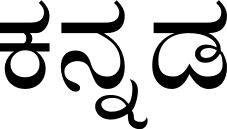Difference between revisions of "Language/Kannada/Grammar/Adjectives"
m (Quick edit) |
m (Quick edit) |
||
| Line 53: | Line 53: | ||
===Class | Adjectives ending in -ing in English (In KANNADA) - YouTube=== | ===Class | Adjectives ending in -ing in English (In KANNADA) - YouTube=== | ||
<youtube>https://www.youtube.com/watch?v=cLRL76yWYTc</youtube> | <youtube>https://www.youtube.com/watch?v=cLRL76yWYTc</youtube> | ||
==Related Lessons== | |||
* [[Language/Kannada/Grammar/Negation|Negation]] | |||
* [[Language/Kannada/Grammar/Questions|Questions]] | |||
* [[Language/Kannada/Grammar/Conditional-Mood|Conditional Mood]] | |||
* [[Language/Kannada/Grammar/Pronouns|Pronouns]] | |||
* [[Language/Kannada/Grammar/Nouns|Nouns]] | |||
* [[Language/Kannada/Grammar/Future-Tense|Future Tense]] | |||
* [[Language/Kannada/Grammar/Gender|Gender]] | |||
{{Kannada-Page-Bottom}} | {{Kannada-Page-Bottom}} | ||
Revision as of 23:07, 25 February 2023
Hi Kannada learners! 😊
In today's lesson, we will be discussing adjectives in the Kannada language. Adjectives are words that describe or modify other words, usually nouns or pronouns. They can be used to give more information about a person, place, thing, or idea. In Kannada, adjectives are used to make sentences more interesting and descriptive.
Types of Adjectives
Adjectives can be divided into two main categories: descriptive adjectives and possessive adjectives.
Descriptive Adjectives
Descriptive adjectives are used to describe the qualities of a noun or pronoun. Examples of descriptive adjectives in Kannada include:
- ಗುಡ್ಡ (gudda) - big
- ಸಣ್ಣ (sanna) - small
- ಹುಟ್ಟಿದ (huttida) - old
- ಕೊಂಚಿನ (konchina) - new
- ಹೆಚ್ಚು (heccu) - much
- ಕಡಿಮೆ (kadime) - little
These adjectives can be used to describe people, places, things, and ideas. For example, ಗುಡ್ಡ ಮನುಷ್ಯ (gudda manushya) means "big man" and ಸಣ್ಣ ಘಟಕ (sanna ghataka) means "small thing".
Possessive Adjectives
Possessive adjectives are used to show possession or ownership. Examples of possessive adjectives in Kannada include:
- ನನ್ನ (nanna) - my
- ನಿಮ್ಮ (nimma) - your
- ಅವರ (avara) - his/her
- ಎಂದು (emdu) - our
- ನಿಮ್ಮನ್ನು (nimmanu) - yours
- ಅವರನ್ನು (avaranu) - theirs
These adjectives can be used to show possession of people, places, things, and ideas. For example, ನನ್ನ ಘಟಕ (nanna ghataka) means "my thing" and ನಿಮ್ಮ ಮನುಷ್ಯ (nimma manushya) means "your man".
Adjective Placement
In Kannada, adjectives usually come after the noun or pronoun they are describing. For example, ಮನುಷ್ಯ ಗುಡ್ಡ (manushya gudda) means "big man" and ಘಟಕ ಸಣ್ಣ (ghataka sanna) means "small thing".
However, there are some exceptions to this rule. For example, when using possessive adjectives, the adjective usually comes before the noun or pronoun. For example, ನನ್ನ ಮನುಷ್ಯ (nanna manushya) means "my man" and ನಿಮ್ಮ ಘಟಕ (nimma ghataka) means "your thing".
Conclusion
In this lesson, we discussed adjectives in the Kannada language. We looked at the two main types of adjectives: descriptive adjectives and possessive adjectives. We also discussed the placement of adjectives in Kannada sentences.
We hope this lesson has helped you gain a better understanding of adjectives in Kannada.
If you have any questions, please ask them in the comments section below.
Feel free to edit this wiki page if you think it can be improved. 😎
Videos
Class | Adjectives ending in -ing in English (In KANNADA) - YouTube
Related Lessons
